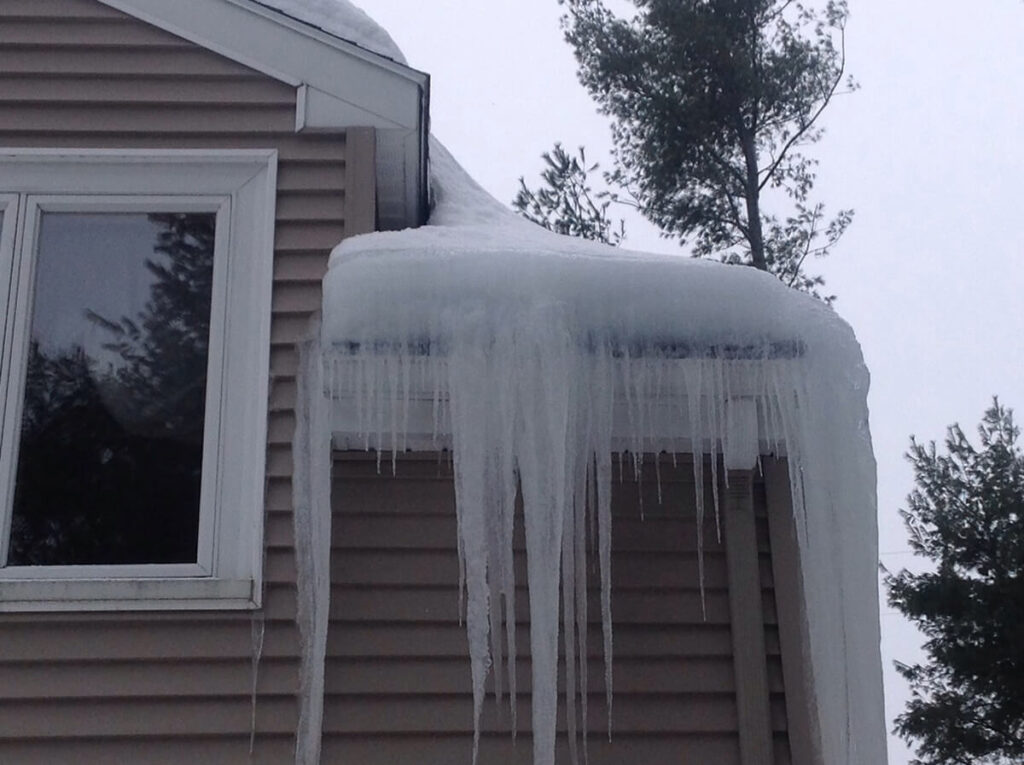
Every winter, we watch Utah homeowners deal with devastating ice dam damage—water damage, destroyed insulation, and repair bills reaching thousands of dollars. At Gutter Boys, we believe prevention beats expensive repairs every time.
Most homeowners wait until icicles hang from their gutters before taking action. By then, ice dams might already be forming, creating problems you won’t notice until water drips through your ceiling. The tricky part? Ice damage often happens gradually, working behind the scenes for weeks before you see obvious signs.
That’s why we’re passionate about heat tape installation and year-round gutter maintenance. After years of emergency calls and costly repairs, we’ve learned that the best defense is a good offense—stopping ice dams before they even start forming.
Why Ice Dams Form in Utah
Ice dams form when warm air escapes from your attic and melts roof snow. That melted water flows to colder gutter edges and freezes solid, creating a barrier that forces water under your shingles.
Utah’s climate makes us particularly vulnerable—cold nights and warmer days create perfect freeze-thaw conditions. Add heavy snowfall from storms rolling off the Great Salt Lake, and you’ve got a recipe for serious problems. We’ve seen ice formations rip gutters off houses, but the real damage happens when trapped water finds its way inside your walls, sometimes causing thousands in hidden damage before homeowners even realize there’s a problem.
Heat Tape: Your Defense System
Heat tape creates a heated pathway preventing ice formation, allowing water to flow freely even when temperatures plummet. We install it along gutter edges and down through downspouts, creating a “thermal runway” for water escape.
We use self-regulating cables that automatically adjust heat output based on temperature. When it’s cold, they work harder. When it warms up, they scale back. This smart technology saves energy and prevents roof damage from overheating.
Constant-wattage cables are another option, though they use consistent power regardless of conditions. For most Utah homes dealing with variable mountain weather, self-regulating systems are more efficient and forgiving.
Strategic Installation: Where It Matters
Proper placement makes the difference between success and failure. We install heat tape in three critical zones: roof edges where ice dams start, throughout gutters, and down every downspout to ground level.
Roof edge installation uses a zigzag pattern extending onto the roof surface, ensuring melted water has a clear heated path. Complete gutter coverage is essential—gaps become ice formation zones that can block your entire system.
Downspout heating often gets overlooked but is crucial. A frozen downspout creates bottlenecks that back water into gutters where it freezes and starts the ice dam cycle.
Professional Installation vs. DIY
While we appreciate DIY spirit, heat tape installation involves electrical work requiring GFCI protection and proper circuit sizing. You’re also working on ladders in icy conditions—exactly when accidents happen.
Improper installation creates fire hazards or worsens ice dam problems. We’ve fixed DIY installations that created uneven heating patterns or used inappropriate cables for specific roof materials.
Professional installation ensures proper electrical connections, strategic spacing, and warranty protection throughout winter.
Essential Gutter Maintenance
Heat tape works best when gutters are already in top condition. Gutter cleaning isn’t just aesthetics—clogged gutters become ice traps that no amount of heat tape can overcome.
We recommend thorough fall cleaning before winter. Debris-filled gutters don’t drain properly, creating standing water that freezes faster. During pre-winter inspections, we check for loose fasteners, proper slope, and damage requiring gutter repair or replacement.
Sagging gutters are particularly problematic because they create low spots where water pools and freezes, even with heat tape installed. We’ve seen minor slope issues turn into major ice formation zones when temperatures drop below freezing for extended periods.
Complementary Prevention Strategies
Gutter guards significantly reduce debris accumulation, making systems more efficient. Proper attic insulation and ventilation also help—less warm air escaping means less melting and refreezing.
Seamless gutter installation improves ice dam resistance with fewer joints where ice can form and create blockages.
When Prevention Fails
Even with prevention measures, watch for warning signs. Large icicle formations, ice extending onto roof surfaces, water stains on walls, or visible ice in gutters despite heat tape operation indicate problems.
When prevention isn’t enough, professional ice dam removal services address problems safely without damaging your roof or gutters.
The Investment Value
Quality heat tape installation costs a fraction of ice dam damage repairs. We typically see systems pay for themselves within two winters through avoided repair costs. Many insurance companies offer discounts for homes with proper prevention systems.
Consider the alternative: emergency removal services, water damage repairs, insulation replacement, and possible mold remediation. Prevention is the smart investment.
Seasonal Maintenance
Prevention systems need winter attention to maintain effectiveness. We recommend monthly visual inspections, watching for unusual ice formation despite heat tape operation.
Monitor electricity usage—sudden spikes indicate system problems. Test your system before the first major snowfall to ensure everything works when you need it most.
Conclusion
Ice dam prevention requires comprehensive planning: clean gutters, properly installed heat tape, and regular maintenance. Don’t wait for emergency repairs—winter preparation should happen in fall when conditions are favorable.
Ready to protect your home before snow flies? Get your free quote today and let’s build a prevention system that’ll keep ice dams away all winter long.